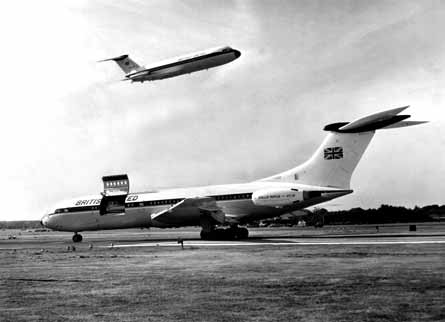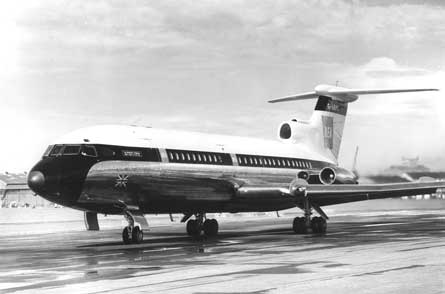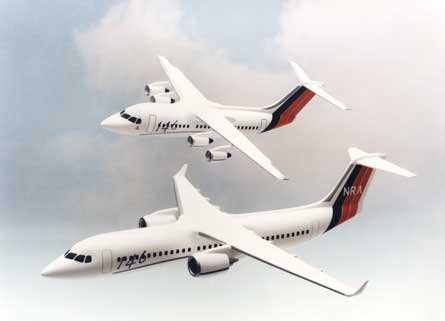BAE's exit from Airbus may be the end of UK ownership in commercial aircraft manufacturing, but its appetite for the sector has been waning for some time
At a recent briefing in London by Airbus chief salesman John Leahy about the company's long-term market forecast, it finally struck home that the UK was out of Airbus.
The lectern from which Leahy spoke was daubed with the familiar swirling logo, but beneath it were the rather lonely words "Airbus - an EADS company". Between the formation of the integrated Airbus in 2001 and the formal sale by BAE Systems of its 20% stake in October for £1.9 billion ($3.6 billion), Airbus had described itself as "an EADS joint company with BAE Systems".
|
|---|
The One-Eleven (top) showed early promise, but the elegant VC10 (bottom) found little commercial success |
Click here to open post-war UK civil aircraft production pdf
So it is official: UK companies no longer have any direct involvement in the commercial aircraft manufacturing business. Well, that is not strictly true - EADS's "Airbus UK" plants at Broughton and Filton (which have a combined workforce of 13,000 - many ex-BAE employees) say they rely on 400 suppliers in the UK.
But the fact remains that, with the sale of BAE's Airbus stake to EADS, those 13,000 Airbus UK employees now work for a Franco-German-Spanish group. And the nation that was the pioneer of jet transport (with the de Havilland Comet of 1949) and the producer of Europe's most successful pre-Airbus airliner (the Vickers Viscount) is now on the sidelines of the business.
The only civil aircraft that remains in production in the UK is the tiny Britten-Norman Islander, which, although technically built in Romania, is the last bastion of a nation that has produced more than 6,000 civil aircraft. According to data compiled by Flight International and its sister division Flight Acas (which produces the Acas database), between the end of the Second World War and the closure of the BAE Avro RJ line in 2003, the UK built 6,033 civil aircraft (including the BAe 125 business jet, which is still being fabricated in the UK). As detailed in the graphic (see opposite), these range from the Handley Page Hermes and Vickers Viking that appeared as the war ended in 1945, to Concorde (half of the 20 built were assembled in the UK) and the BAe 146/Avro RJ, which, despite more than 20 years of production, failed to beat the 444 sales record set by the Viscount in the 1960s.
The path to BAE's involvement in Airbus has already been well documented - it became a fully paid-up 20% shareholder in 1979 (as the nationalised British Aerospace), having baulked at joining the Franco-German consortium when it was formed in 1970 despite the fact that the UK was on the original "European air bus" steering group in the 1960s. Hawker Siddeley Aviation (HSA) had kept the Union flag flying from the creation of Airbus, taking on the design and construction of the A300's wing as a subcontractor.
Just as Airbus Industrie was about to be created, the UK government announced on 10 April 1969 it would not be signing up - perhaps coincidentally, one day after the first UK-assembled Concorde made its maiden flight from Filton. That decision arguably created a situation that led directly to the UK's withdrawal 37 years later.
International co-operation
Announcing the decision, the UK's then Labour minister of technology Anthony Wedgwood Benn said the government was "not satisfied that it was a good investment to go ahead with the project at this stage". The UK was being asked to find one-third of the estimated £180 million development costs for the "A-300" widebody - an aircraft that, at the time, was attracting little interest from potential customers.
The UK was already up to its neck in civil aircraft investment through British Aircraft Corporation's (BAC) 50/50 joint venture with Sud Aviation (later Aerospatiale) in the Anglo-French Concorde programme - an aircraft that had then accumulated an impressive tally of commitments and was perceived as the future of air transport development.
While Concorde heralded much of the cross-Channel co-operation that would be a cornerstone of Airbus Industrie, it differed in some key areas where national pride influenced decisions that should have been based purely on sound business strategy - the duplicated production lines in France and the UK, and the requirement that systems and equipment be sourced from French and UK companies. Not only did this eliminate the ability to spread the risk (and eventually the reward, had it been successful) outside the two partner nations, but also added to the cost of the programme and led to some complex organisational structures when the development of a system was carved up and allocated to companies on each side of the English Channel.
While the UK had backed the wrong horse with Concorde, the SST's French partner, Sud Aviation, pursued a parallel course by becoming a founder-member of Airbus Industrie with Germany. The result: Toulouse Blagnac airport - the home of Sud Aviation - is now the most important aerospace city in Europe and, arguably, the world. Meanwhile, in the UK, most of the old BAC and HSA civil aircraft plants no longer exist, with the exception of Filton near Bristol and Broughton in north Wales.
But it could all have been very different. Events during the past 60 years have conspired to gradually erode the UK's frontline participation in the airliner business, including some recent developments. In the late 1990s, before the spark that led to the creation of EADS through the merger of Aerospatiale Matra and Germany's DASA - the move that marginalised the UK's Airbus position - it was BAe and the Germans that looked the most likely of Europe's aerospace giants to tie the knot.
Financial problems
In 1998-9, Germany and the UK were close to a pan-aerospace tie-up that would have left France's industry as the minority partner in Airbus, but then BAe decided to grab the UK's Marconi Electronic Systems, ending prospects of a tie-up with DASA.
This left Germany (which had acquired Spain's CASA) and France ready to move closer as the newly created BAE Systems focused on its defence and systems integration businesses.
The reality is that BAE and its recent predecessors had no appetite for civil aerospace. The UK has never seriously entertained the idea of an Airbus final assembly line - something the German partner pushed for and achieved with the launch of the A321 in 1989.
BAe ran into financial problems in the early 1990s when its share price tumbled and in 1992 it was forced to write off £1 billion of assets, primarily because of the restructuring of its regional aircraft division. Included in this was the closure of the historic former de Havilland plant at Hatfield, near London, which spawned the Comet. Almost half of BAe's 127,000-strong workforce went during this reorganisation, 40,000 of whom were from its regional aircraft division.
BAe's regional tie-up with the Franco-Italian ATR in the mid-1990s promised much, but delivered little. By the time the AI(R) consortium, as it was dubbed, was putting together serious plans for what would have been the first large regional jet (the "Airjet"), BAe was already plotting a tactical withdrawal from the regional airliner industry, so these studies came to nothing. Ironically, a decade on ATR stands alone as the only regional airliner builder exclusively producing turboprops, and its Italian partner Alenia Aeronautica has signed an agreement with Russia's Sukhoi to take part in the 75- to 100-seat Superjet 100 programme.
Arguably, the BAe 125 was the UK's most successful turbine-powered civil aircraft programme, with deliveries having averaged about two a month since it began life in 1962 as the DH125. But this programme was a victim of BAe's strategy to dispose of "non-core activities", when it sold its Corporate Jets division to Raytheon in 1993.
Civil programme
BAe knew it needed to invest some serious money in its corporate jet business to remain competitive with the growing band of dedicated executive jet builders, and the sale to Raytheon enabled it to cash in on the success of the programme before it ran out of steam. But many observers felt the earnings from this successful programme had been squandered on propping up the remainder of BAe's largely uncompetitive civil programmes, leaving the 125 in desperate need of some development investment. Significantly, the largely similar Hawker 850 continues to sell strongly today, and all major subassembly work remains in the UK at the Airbus UK Broughton plant.
|
|---|
The Trident failed on the world market as it was designed for just one customer |
By the end of the 1990s, despite the demise of BAe's main regional rival, Fokker, the UK had lost its ambition to be a serious player in the civil sector outside Airbus. AI(R) had achieved little except to confirm the demise of the UK's remaining turboprop projects - the Jetstream 31, 41 and 61 (née ATP). The Avro RJ soldiered on with a third-generation development, the RJ-X, which began flight testing, but the sudden downturn in the autumn of 2001 after the 9/11 terrorist attacks gave BAE the excuse it needed to finally extinguish any remaining aspirations to build airliners.
But the same was not true of its involvement in Airbus. BAE enjoyed the sizeable revenue and profits that its Airbus activities generated, and was fully behind the 1999-2000 revamp of the original consortium structure into an integrated company as it prepared to create the world's largest airliner, the A380. No longer would BAE staff and plants supply parts to another Airbus partner instead, all the Airbus operations across Europe were merged into one, with BAE holding a 20% stake in the company that ran them.
But all that glitters is not necessarily gold, and by early this year BAE could see some dark clouds on the Airbus horizon. Arguably, it waited just a little too long to decide to sell out to EADS but, given the woes currently being suffered in Toulouse, it is certainly not a move it now regrets.
|
|---|
The twin-engined 146 NRA might have kept BAe in the civil airliner game for another generation |
Source: Flight International





























